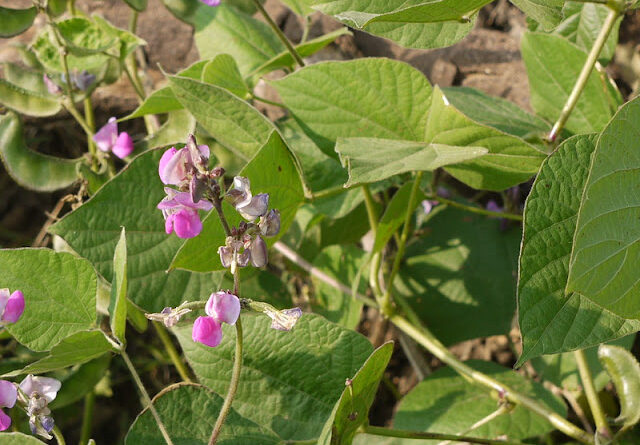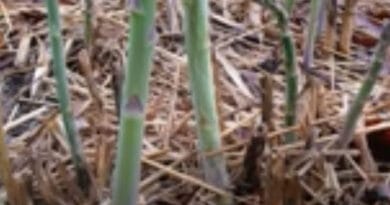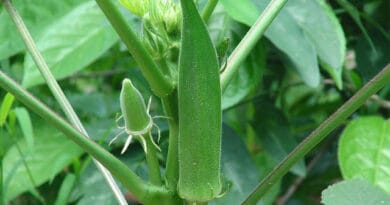Cultivation of Indian Bean ; Dolichos lablab /Sem
Indian Bean Dolichos lablab (Roxb) & L. belongs to the legume family Fabaceae. It is also known as the Hyacinth bean and popularly known as ‘Sem’. It is a multipurpose crop cultivated for a pulse, a vegetable, and forage. Indian bean is primarily grown for its green pod. Young pods are cooked as vegetables. Indian beans are used for the pod, feed, and soil improvement. Major growing states are Maharashtra, Tamil Nadu, UP, Andhra Pradesh, and NE India. Wild beans are found in India, which is probably the center of origin. From India, it was likely introduced into China, Western Asia, and Egypt
Nutritive Value of Indian Beans: The nutritive value of an Indian bean in 100 g of an edible portion is given below –
| Serving Size 100 g | %DV | |
| Calories | 347 kcal | |
| Total Carbohydrate | 63 g | 21% |
| Dietary Fiber | 16 g | 64.00% |
| Sugar | 2.1 g | |
| Protein | 21 g | 42% |
| Cholesterol | 0 | 0% |
| Saturated fat | 0.2 | 1% |
| Sodium | 12 mg | 0% |
| Potassium | 1.39 mg | 39% |
| Iron | 28% | |
| Calcium | 11% | |
| Vitamin C | 10% | |
| Vitamin B6 | 28% | |
| Magnesium | 44% | |
| Vitamin D | 0% | |
| Cobalamin | 0% | |
| *Percent Daily Values are based on a 2,000-calorie diet. Your daily values may be higher or lower depending on your calorie needs. | ||
Climatic Requirements for India Bean Cultivation
Indian bean is well adapted to tropical and subtropical conditions. Indian bean is relatively a cool-season and drought-resistant crop. The plants start fruiting from the beginning of the cold season, two and a half to three months after sowing, and continue to give green pods throughout the winter and spring months
Soil and Its Preparation for India Bean Cultivation
An Indian bean can grow in a wide range of soils. But loam, silty-loam, and clay-loam soils are best suited for Indian beans. The land is prepared thoroughly by giving 5-6 ploughing.
Varieties of Indian Bean /Sem
Varieties | Characteristics |
Arka Vijay | Developed through the back cross and pedigree selection involving the Parents Hebbal Avare x IIHR 93. Plants dwarf, bushy, erect, and photo insensitive, Leaves dark green, Flowers white., Pods are short dark green. Seeds bold., Pods with characteristic aroma, without parchment., Vegetable type with excellent cooking qualities. Tolerant to low moisture stress. Duration 75 days. Pod Yield 12 t/ha. |
Arka Jay | Leaves are light green, flowers are purple pods are light green and slightly curved bulged around the midline, and are without aroma, yield 10-12 tons per hectare in 85 days |
Konkan Bhushan | It is a bush-type plant, 60–75 cm tall, matures in 55–60 days after sowing. The pods are tender and stringless. A plant produces 125–180 pods. It is adaptable to various types of soils and climates.,Pod yield 12 – 14 tons/ha in 90 to 100 days |
Pusa Early Prolific | It is a pole-type bean, suitable for the autumn and spring seasons. It is an early variety, bears long, thin pods. |
Blue Lake | It is an early variety. The color of the seed is brown length of the pod is 6 to 8 cm. It becomes ready for harvesting 70-80 days after sowing. |
Arka Amogh | Plants are medium tall, 50 % flowering in 40 days, and pods are ready for harvest in 55 days. Pods are similar to Arka Jay and Konkan Bhushan. Yield: 19-20 t/ha. |
Arka Sambhram | Plants are medium height, 50 % flowering in 40 days and pods are ready for harvest in 55 days. Pods are flat, light green, medium-long (13-15 cm), medium width (1.5 cm). Yield: 19-20 t/ha |
Arka Soumya | Plants are medium tall, 50 % flowering in 45 days, and pods are ready for harvest in 55 days. Pods are slender (1.0 cm width), and medium long (13-15 cm).Yield: 19 t/ha |
Hebbal Avare-3 | Developed at UAS, Bangalore. It takes 70-75 days to harvest and grow in all seasons throughout the year. Flowers are Photo-insensitive. Seeds are brown, round, and short duration (100 days) |
CO-2 | Photosensitive. The pods are deep purple throughout, septate, and fleshy. Yields 135 t/ha in 215-220 days. |
CO-5 | It is a pure line selection from local type Kozhikkal aware Characters: All are one pole type, photo-insensitive, pods are light green to deep purple. Yield about 8-11t/ha in 210-220 days. |
CO-13 | It is a bush type, a hybrid derivative of CO-9 (bush type) x Florika field. Photo insensitive, flowers white with long green pods, yields 10t/ha. |
Deepaliwal and Dasarawal | Released from PRKV, Akola, Maharashtra. Pole-type bean, pods are extra long, and whitish in Deepaliwal whereas purple-green in Dasarwal yields about 6-8t/ha in 200-210 days. |
Pusa Sem-2 and Pusa Sem-3 | Released from IARI, New Delhi. Pole type, pods are borne on separate spike in bunches above the plant canopy. Pods are dark green, tender, stringless, fleshy, and borne in clusters of 11-13 members. Highly tolerant to anthracnose, YVMV, aphids, jassids, pod borers, and frost. Yields about 13.7t/ha. |
Sowing of the Seed of the Indian Bean
(a) Time of sowing. Field varieties are sown with the advent of monsoon in July-August, come into flower in November-December, and are harvested in January-February in frost-free areas
(b) Seed rate. The seed rate is 5 to 6 kg per acre.
(c) Method of sowing. The seeds may be sown in rows, or on ridges by drilling or by dibbling. The spacing between the rows is 1.0 to 1.5 m apart between the rows and 1 m. Apart between the ridges is recommended. It is also commonly grown near houses and allowed to climb on rooftops
Manuring in Indian Bean
Depending upon the fertility status of the soil, it needs 8-12 tons of F.Y.M., 6-8 kg of Nitrogen, 20-30 kg of Phosphorus, and 20 kg of Potassium per acre.
Irrigation of Indian Bean Fields
Indian bean is commonly cultivated as a rainfed crop. Irrigation will be given as and when required.
Pests and Diseases of Indian Bean;
Insect | Symptoms | Control |
Aphid | Aphids are insects with a soft body, tiny, 1-2 cm long, black to greenish. They suck the sap, causing curling, thickening, yellowing and finally drying of the leaves and devitalise the plant. Attacked fruits and flowers do not show further development. | Spraying of pyrethrum at 1:800 dilution or nicotine sulphate as 1: 600 or 0.1% lindane or parathion 0.25% is recommended to control the aphids. If fruit formation had not taken place, malathion 50% at 3 ml in 5 liters of water may be done. Pods treated with malathion should not be harvested or consumed for about a week. |
Pod borers | There are three different species of pod borers, out of which Adisura atkinsoni is a common one on Dolichos lablab. Cold weather is congenial for its development when the field beans suffer considerable damage. The larvae make holes in the pods and damage the crop | Spraying Pyrethrum is recommended. If the pest occurs just at the time of fruit formation, Hand picking of the caterpillars in early stage of attack helps in reducing the intensity of the infestation ploughing the fields after harvest of the crop would expose the pupae which would be destroyed by birds. |
Lablab bug | It is a small, oval shaped stick bug. Both the adults and nymphs in large numbers suck sap causing fading and drying of the leaves and vines. It is usually observed on beans. | It is difficult to control the pests in the field. |
Mites | Eutetranychus orientalis L. is among various pests infesting Dolichos bean and causing considerable losses | Spraying the crop with 0.05% dicofol was the most effective. |
Diseases of Indian Bean
Disease | Symptom | Control |
Anthracnose | They affect the above-ground parts, e.g., leaf, stem, and pod anthracnose. Lesions on stems and pods are more clearly defined than those on leaves, grey or brown, slightly sunken with raised dark brown or reddish edge. All vegetative parts, except pulvini, are susceptible during early stages of development; invasion of the tap root of a young plant can lead to death. Elongated dark-brown or black sunken spots with reddish or yellowish margins appear on veins, petioles, stem and pods. Diseased seeds carry the fungus from season to season. Spots on the hypocotyl cause death of the plant. Seedlings show canker on cotyledons. These lesions produce pinkish spore masses during moist weather.
| Sowing disease-free seed, crop rotation, and field sanitation. Treat seeds for half an hour in 0.125% solution of ceresan or 1% organomercurial fungicide (Seedex). Dust seedex or captan at 3 g per kg of seed. Additionally, spray Bordeaux mixture 5:5:50 or a copper fungicide at 1 kg in 250 liters of water as soon as the symptoms appear. |
Powdery mildew | Lablab bean is affected mostly by Leveillula taurica var. macrospora. White floury patches are formed on both sides of the leaves and all portions of the above ground parts, which gradually turn brown. The leaves become yellow and die, while fruits either do not set or remain small. It is a seed borne as well as a soil-borne disease and causes serious damage in the dry weather. | To control this disease, field sanitation is important. Diseased plants should be collected and burnt. The crop may also be dusted with 200-mesh sulfur at 25-30 kg per hectare at 10-15 days intervals or spray wettable sulphur at 1 kg in 500 liters of water. (Spray with 0.5% wettable sulfur or with benlate or Bavistin 0.15%.) |
Rust | Red and black pustules appear on the lower surface of the leaves. Attacked leaves turn yellow and drop off. | Dusting sulfur at the rate of 25-30 kg/ha protects the crop. Spraying Bordeaux mixture in the early stages also prevents spread. |
A ringspot virus | Affected leaves turn yellowish green, wrinkled and stiff. Though it rarely kills the plants, the growth is retarded and vines do not bear fruits or deformed pods. | Rouging and clean cultivation is recommended. |
Root-Knot nematodes | They cause severe growth retardation and characteristic root galls. The symptoms include stunting, loss of yield, reduction in quality of pods; severe deficiency symptoms of some elements, incipient wilting during hot periods of the day, increased susceptibility of foliage diseases of vascular wilts. | To control root-knot nematodes, resistant plant varieties and chemicals are used. Crop rotation can reduce population levels of root-knot nematodes when beans are planted once every two or three years in rotation with non-hosts such as maize. |
Harvesting of Indian Beans
Yield of Indian Beans
Read Further;



